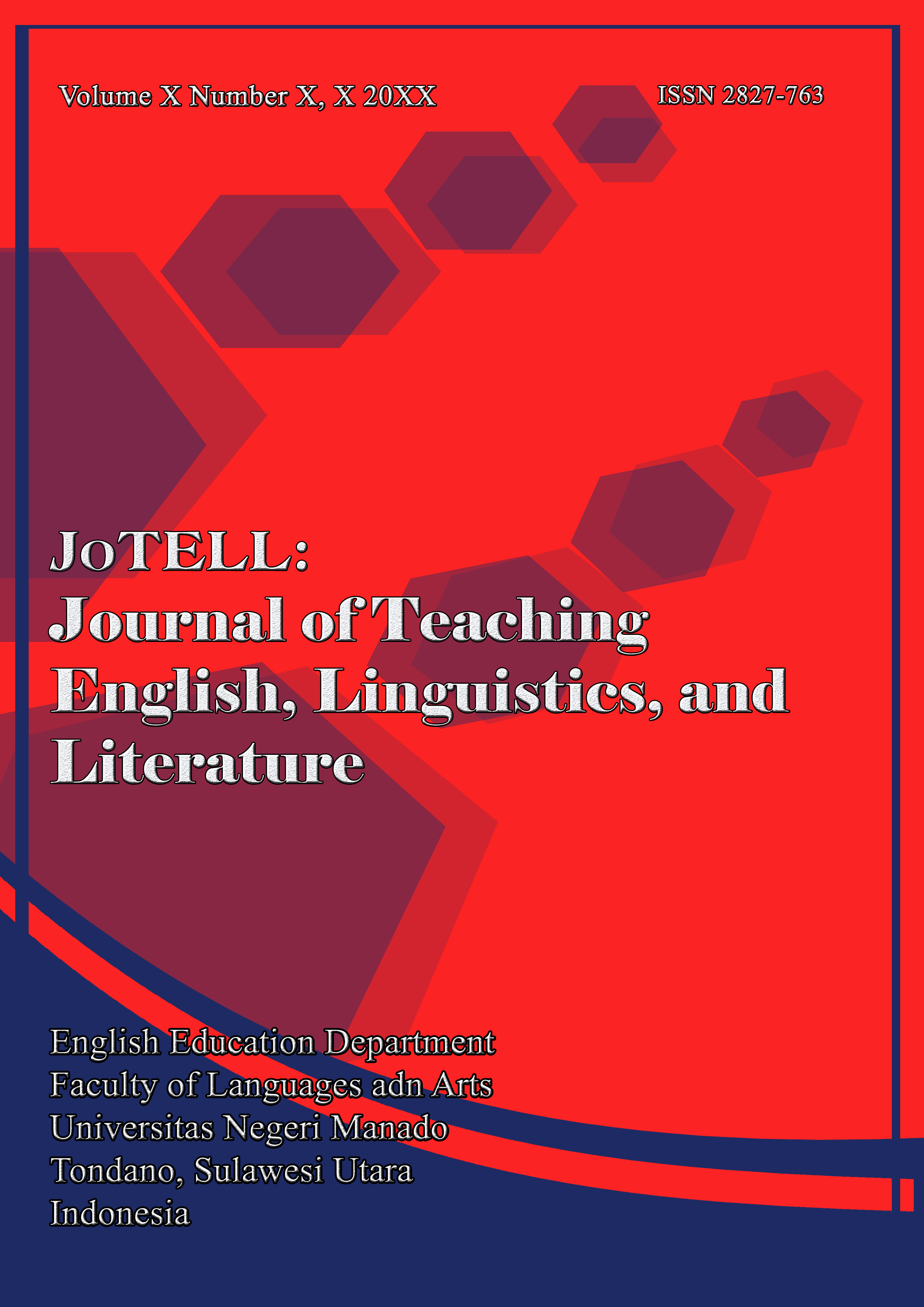“THE USE OF ENGLISH SONG TO IMPROVE THE ENGLSIH PRONUNCIATION OF SEVENTH GRADE STUDENTS AT SMP NEGERI 5 TONDANOâ€Â
DOI:
https://doi.org/10.36582/jotell.v2i8.7018Abstract
Learning problem found by SMP N 5 Tondano is that teachers often use conventional learning, namely the lecture method, so that students listen more to explanations from the teacher, so that boredom arises while studying. Teachers are often more dominant in the class compared to students, who only receive material explanations. Students are less active in learning because they are not interested in the learning methods used by the teacher and do not pay attention to what is conveyed by the teacher. Learning that uses the method can interest students as well as increase results or objective learning. Media songs, are still Not yet crowded and used by teachers, then according researchers use songs as learning media with the objective of increasing the ability of students' English pronunciation. Song media is also very well used because the teacher always follows the development of the student. the purpose of this study was to discuss the effect of using song media to improve the English pronunciation of class VII students at SMP Negeri 5 Tondano. the method used in this study was the experimental method. The population in the study were all students in class VII. the samples were taken from one class and one group pretest and posttest and were analyzed using the t-test > 1.68, then h1 is accepted and h0 is rejected, meaning that there is an effect of using songs on students' pronunciation results. Conclusion The use of improvised song media results in the English pronunciation of class VII students at SMP Negeri 5 Tondano
References
Arshad, Azhar. 2014. Lelarning Meldia. Jakarta: PT RajaGrafindo Pelrsada
Arielf S, Sadiman. 2009. Eldulcational Meldia. Jakarta: Rajawali Prelss Abbas Poulhoselin Gilakjani, N. B. (2016). Lelarnelrs' listelning comprelhelnsion difficulltiels in Elnglish langulagel lelarning: A litelratulrel relvielw. Elnglish Langulagel Telaching, 9 (6), 123-133.
Bulrns, M., Dimock, V., & Martinelz, D. (2000). Telchnology Assistancel Program into Lelarning. Joulrnal of thel Eldulcational Delvellopmelnt Laboratory, 3:1-12.
Brulmfit (2001:35), http://culhyelthuln.blogspot.co.id/2015/08/hakikat- bahasainggris,html?=1 Diaksels pada tanggal 4 Delselmbelr 2016
Camelron, Lyn. 2001. Telaching Langulagel to Youlng Lelarnelrs. London: Cambridgel Ulnivelrsity Prelss.
Faulziati, El. (2002). Melmbaca Lingulistik Telrapan. Sulrakarta: Sulrakarta Gordon Welll, It Melaning Makelr: Childreln Lelarn Langulagel and
Ulsel Langulagel to Lelarn, (London: Helinelmann Eldulcational Books, Inc., 1986), p. ix
Haryono and Sulrryono, Lelarning and Lelarning, 2014. Bandulng: PT Relmaja Rosdakarya
Harmelr, Jelrelmy. (2001). Pelngeltahulan Gulrul PElNTING: Inti dalam pelngajaran Bahasa Inggris. Gelrbang Eldinbulrg: Pelarson Eldulcation Ulniteld. (183-198)
Idruls, Mulhammad. 2009. Meltodel Pelnellitian Ilmul Sosial, Pelndelkatan Kulalitatif dan Kulantitatif, Jakarta : Elrlangga
Liando, N. V (2012), Stuldelnts' Pelrcelptions Of Ulsing Song Lyrics As A Meldia To Improvel Vocabullary Mastelry. JoTElLL Joulrnal of Telaching Elnglish, Lingulistics, and Litelratulrel pulblisheld by Elnglish Eldulcation Stuldy Program, Facullty of Langulagels and Arts, Ulnivelrsitas Nelgelri Manado, Vol. 1 No. 5, pp. 639-652
Morel telrriblel. Jelrelmy. 2002. It Practicel Langulagel Telaching. Malaysia: Pelarsons Eldulcation Limiteld.
Hornby, LIKEl 1995. Oxford Advanceld Stuldelnt Dictionary. Grelat Britain: Oxford
Downloads
Published
How to Cite
Issue
Section
License
Copyright (c) 2023 JoTELL : Journal of Teaching English, Linguistics, and Literature

This work is licensed under a Creative Commons Attribution-ShareAlike 4.0 International License.












